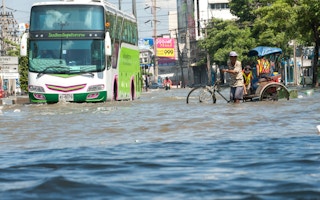When US President Barack Obama announced a $3 billion pledge to a new international climate change fund, he made a point of highlighting how the money would help poor countries hit by worsening extreme weather and rising seas.
Climate change adaptation - measures that protect people and assets, such as early warning systems and more resilient crops - has gained far less cash and attention than mitigation efforts, which aim to reduce planet-warming greenhouse gas emissions.
That is an imbalance experts hope the fledgling Green Climate Fund (GCF) - which holds its first pledging conference in Berlin on Thursday - can start to rectify.
The GCF, which is expected to handle billions of dollars in climate finance in the coming years, plans to help drive a larger share of international climate finance towards adaptation, according to its executive director.
“
Countries judged to be most vulnerable in international rankings are getting very little adaptation funding per person, suggesting that climate finance is not being directed where it is most needed
“This is a priority,” Héla Cheikhrouhou told the Thomson Reuters Foundation in an interview.
In sharp contrast, some three quarters went to mitigation projects, which aim to cut carbon pollution and raise investment in clean energy and forest protection.
Brandon Wu, a senior policy analyst at ActionAid USA, said donor governments are “much more comfortable” with mitigation than adaptation, because they see it as better defined, and can measure its effectiveness more easily.
Wind or solar power projects, for example, can be funded with loans rather than grants and tend to be more attractive to business than providing community evacuation alerts or training farmers to plant drought-tolerant crop varieties.
Neglected
This preference for more tangible, even profitable, investments has left many of the poorest people with next-to-no international aid to protect them from the heat waves, droughts, floods and storms that are predicted to worsen as global temperatures and sea levels rise.
Quamrul Chowdhury, a Bangladeshi negotiator at UN climate talks, said the “adaptation deficit” has made it much harder for the most vulnerable countries to fight what he termed “runaway climate change”.
Analysis by the Thomson Reuters Foundation using data from Climate Funds Update shows that countries judged to be most vulnerable in international rankings are getting very little adaptation funding per person, suggesting that climate finance is not being directed where it is most needed.
International climate funds have approved less than $2 of adaptation funding per capita for around two-thirds of the 32 countries identified as at “extreme risk” in the 2015 Climate Change Vulnerability Index compiled by global risk analytics firm Maplecroft.
Similarly, less than $2 per person has been allocated to just over half of countries categorised in the Notre Dame Global Adaptation Index as highly vulnerable to climate change but with low readiness to improve their resilience.
Alice Caravani, a researcher for the London-based Overseas Development Institute who works on the climate funds database, said the countries that are receiving very little may have problems absorbing money due to political instability or not having the right institutions in place.
But as adaptation finance continues to grow, “it is likely that more countries will benefit from it, including the vulnerable ones that have been neglected so far,” she said.
More to most vulnerable
The Green Climate Fund’s board has agreed to aim for a “50-50” balance between the funding it provides for climate change mitigation and adaptation “over time”.
Officials have also said it will allocate no less than half of adaptation funds to countries most vulnerable to the impacts of climate change, including the 49 least-developed nations.
As climate impacts bite around the world, growing amounts of national budgets and private-sector spending are going to adaptation measures on the ground - but that work has not been supported as it should be by multilateral climate funds, said Cheikhrouhou of the GCF.
The time is ripe for a shift, she noted, as knowledge has accumulated in recent years on how to effectively adapt to climate change, with measures like improving access to water and food supplies, constructing more resilient infrastructure in cities and offering insurance against extreme weather.
“That makes it much more realistic to have a good pipeline of projects and programmes on adaptation” in both the public and private sectors that could seek funding, Cheikhrouhou said.
Not ready?
ActionAid’s Wu, who has attended most GCF board meetings, said the fund is making progress on preparations to put money into adaptation efforts, though he urged it not to channel too much through U.N. and other multilateral development agencies.
“The more you can devolve control over funding to local actors, the more effective you’re going to be in responding to adaptation needs,” he said.
Joyce Coffee, managing director of the Notre Dame Global Adaptation Index, said the GCF would need to give itself time to build the capacity of fragile states that are not yet ready to receive large amounts of international climate funding due to high political risk and weak government institutions.
“The readiness element is incredibly important, because otherwise money could be wasted,” she said.
“The best approach might be to invest in countries that have known (climate) vulnerabilities but are improving their governance and social structures, like Rwanda and Botswana in Africa,” she said, “and say to the others, ‘you need to clean up your act’.”
Cheikhrouhou said that in countries recovering from conflict, for example, the GCF could work through organisations that meet its fiduciary, environmental and social standards, such as multilateral agencies or private banks.
“What we care about is the ultimate result - whether we are indeed helping save lives from vulnerability, and whether we are indeed helping choose a cleaner development pathway,” she said.

















